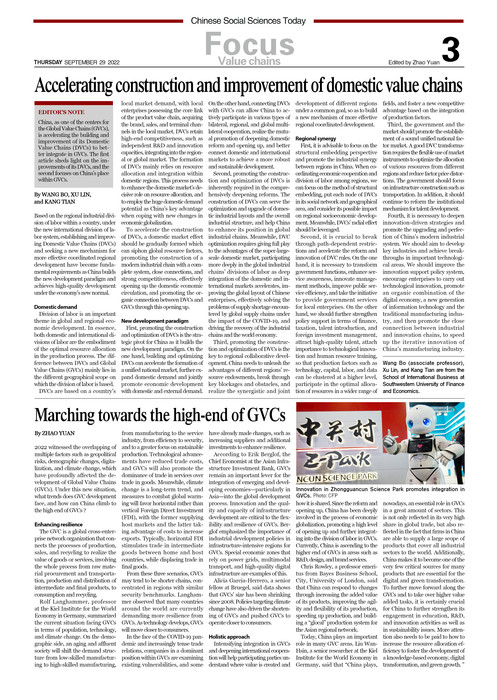Marching towards the high-end of GVCs
2022-09-29 14:38:32
Innovation in Zhongguancun Science Park promotes integration in GVCs. Photo: CFP
By ZHAO YUAN
2022 witnessed the overlapping of multiple factors such as geopolitical risks, demographic changes, digitalization, and climate change, which have profoundly affected the development of Global Value Chains (GVCs). Under this new situation, what trends does GVC development face, and how can China climb to the high end of GVCs ?
Enhancing resilience
The GVC is a global cross-enterprise network organization that connects the processes of production, sales, and recycling to realize the value of goods or services, involving the whole process from raw material procurement and transportation, production and distribution of intermediate and final products, to consumption and recycling.
Rolf Langhammer, professor at the Kiel Institute for the World Economy in Germany, summarized the current situation facing GVCs in terms of population, technology, and climate change. On the demographic side, an aging and affluent society will shift the demand structure from low-skilled manufacturing to high-skilled manufacturing, from manufacturing to the service industry, from efficiency to security, and to a greater focus on sustainable production. Technological advancements have reduced trade costs, and GVCs will also promote the dominance of trade in services over trade in goods. Meanwhile, climate change is a long-term trend, and measures to combat global warming will favor horizontal rather than vertical Foreign Direct Investment (FDI), with the former supplying host markets and the latter taking advantage of costs to increase exports. Typically, horizontal FDI stimulates trade in intermediate goods between home and host countries, while displacing trade in final goods.
From these three scenarios, GVCs may tend to be shorter chains, concentrated in regions with similar security benchmarks. Langhammer observed that many countries around the world are currently demanding more resilience from GVCs. As technology develops, GVCs will move closer to consumers.
In the face of the COVID-19 pandemic and increasingly tense trade relations, companies in a dominant position within GVCs are examining existing vulnerabilities, and some have already made changes, such as increasing suppliers and additional investments to enhance resilience.
According to Erik Berglof, the Chief Economist at the Asian Infrastructure Investment Bank, GVCs remain an important lever for the integration of emerging and developing economies—particularly in Asia—into the global development process. Innovation and the quality and capacity of infrastructure development are critical to the flexibility and resilience of GVCs. Berglof emphasized the importance of industrial development policies in infrastructure-intensive regions for GVCs. Special economic zones that rely on power grids, multimodal transport, and high-quality digital infrastructure are examples of this.
Alicia Garcia-Herrero, a senior fellow at Bruegel, said data shows that GVCs’ size has been shrinking since 2008. Policies targeting climate change have also driven the shortening of GVCs and pushed GVCs to operate closer to consumers.
Holistic approach
Intensifying integration in GVCs and deepening international cooperation will help participating parties understand where value is created and how it is shared. Since the reform and opening up, China has been deeply involved in the process of economic globalization, promoting a high level of opening up and further integrating into the division of labor in GVCs. Currently, China is ascending to the higher end of GVCs in areas such as R&D, design, and brand services.
Chris Rowley, a professor emeritus from Bayes Business School, City, University of London, said that China can respond to changes through increasing the added value of its products, improving the agility and flexibility of its production, speeding up production, and building a “glocal” production system for the Asian regional network.
Today, China plays an important role in many GVC areas. Liu Wan-Hsin, a senior researcher at the Kiel Institute for the World Economy in Germany, said that “China plays, nowadays, an essential role in GVCs in a great amount of sectors. This is not only reflected in its very high share in global trade, but also reflected in the fact that firms in China are able to supply a large scope of products that cover all industrial sectors to the world. Additionally, China makes it to become one of the very few critical sources for many products that are essential for the digital and green transformation. To further move forward along the GVCs and to take over higher value added tasks, it is certainly crucial for China to further strengthen its engagement in education, R&D, and innovation activities as well as in sustainability issues. More attention also needs to be paid to how to increase the resource allocation efficiency to foster the development of a knowledge-based economy, digital transformation, and green growth. ”



